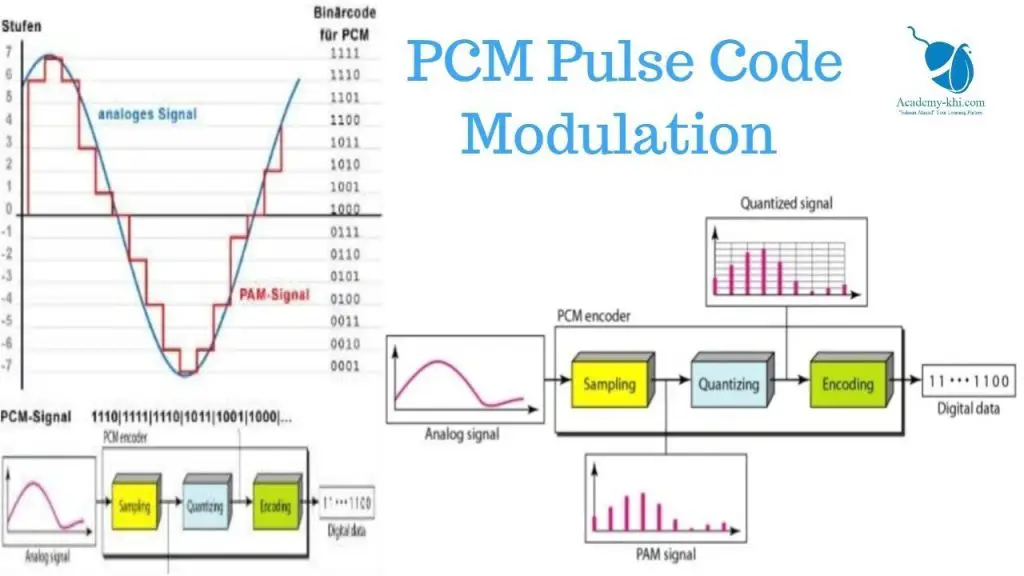Pulse-code modulation (PCM) is a method used to digitally represent sampled analog signals. It is the standard form of digital audio in computers, Compact Discs, digital telephony and other digital audio applications. In a PCM stream, the amplitude of the analog signal is sampled regularly at uniform intervals, and each sample is quantized to the nearest value within a range of digital steps.
Linear pulse-code modulation (LPCM) is a specific type of PCM where the quantization levels are linearly uniform. This is in contrast to PCM encodings where quantization levels vary as a function of amplitude (as with the A-law algorithm or the μ-law algorithm). Though PCM is a more general term, it is often used to describe data encoded as LPCM.
A PCM stream has two basic properties that determine the stream's fidelity to the original analog signal: the sampling rate, which is the number of times per second that samples are taken; and the bit depth, which determines the number of possible digital values that can be used to represent each sample.
For a little history, In the United States, the National Inventors Hall of Fame has honored Bernard M. Olive and Claude Shannon as the inventors of PCM, as described in "Communication System Employing Pulse Code Modulation", U.S. Patent 2,801,281 filed in 1946 and 1952, granted in 1956. Another patent by the same title was filed by John R. Pierce in 1945, and issued in 1948: U.S. Patent 2,437,707. The three of them published "The Philosophy of PCM" in 1948. The patents have been long expired, so it's free real estate.
So, what's the the pros and cons?
Pros:
- Higher bitrate (depending on the media format you're using)
- Public Domain, meaning no licensing required. (It's free real estate)
- Takes up alot of space.
For physical media, Laserdiscs were the first optical media to add optional PCM digital sound often branded with a "Digital Sound" logo in the West and "Digital Audio" logo in Japan.
The compact disc (CD) brought PCM to consumer audio applications with its introduction in 1982. The CD uses a 44,100 Hz sampling frequency with 1.5 megabits per second and 16-bit resolution and stores up to 80 minutes of stereo audio per disc.
DVD Video offer PCM at a bitrate of 6 Megabits per second 16-bit 48 kHz up to 8 channels.
For DVD Audio, the audio is stored on the disc PCM, which is either uncompressed or losslessly compressed with MLP (Meridian Lossless Packing). The maximum permissible total bit rate is 9.6 Megabits per second with 6 channels.
For Blu-ray, PCM reaches the maximum bitrate of 27.648 Megabits per second.
PCM audio can be contained in a WAV file, more uncompressed than MP3.
PCM is often used for CD albums and many video games often from the fifth, sixth, and eight generations on PC and console. (Seventh generation often used Dolby Digital for compression methods)
When Blu-ray was first released in 2006, many studios added uncompressed PCM audio soundtracks, but after 2010 many have switched to the licensed DTS Master Audio because of it's same audio quality but compressed, using less disc space to add more video. Many smaller studios and distributors today like Criterion and Discoteck still use PCM.
Many people today from music artists, indie movie makers, indie game creators use PCM for authoring uncompressed soundtracks because of it's high bitrate, uncompressed and no licensing required.
There is no unified logo for PCM, and the original "digital sound" logo's copyright status in unknown so we made open-source PCM logos for ANYONE to use for commercial use under the Creative Commons Attributions 4.0 license. https://creativecommons.org/licenses/by/4.0/
 |
| Standard logo |
 |
| For stereo tracks |
 |
| For mono tracks |
 |
| For 5.1 Surround Sound |
 |
| For 6.1 Surround Sound |
 |
| For 7.1 Surround Sound |
 |
| Variant logo showing the sound is uncompressed. |
 |
| For video games to provide stereo spacialization (sound location) to extend the interactive playing experience. |



Comments